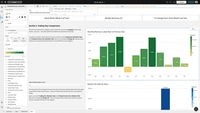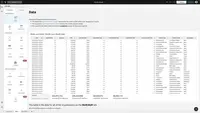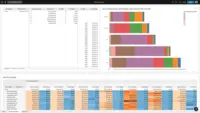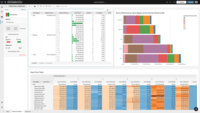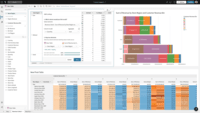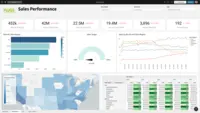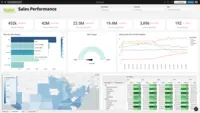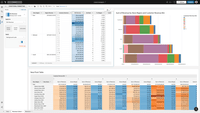Overview
What is Sigma?
Sigma Computing headquartered in San Francisco provides a suite of data services such as code free data modeling, data search and explorating, and related BI and data visualization services.
Great tool with some weird kinks
Sigma Recommended.
Sigma Rolling Out.
My Sigma Review
Sigma Review
Nearly perfect, missing some nice to have features
I tell everyone about Sigma!
Great BI tool loved by many business stakeholders
A data analysis tool that is easy implement and easy to learn.
Love Sigma
Getting data into your users' hands quickly and easily
Excellent Tool for Business Analysis
Actionable and fun data analytics
Sales Ops Usage
How Sigma Differs From Its Competitors
Self-Service Analytics
Self-Service Analytics
Ad Hoc Analytics
Self-Service Analytics
Self-Service Analytics
Ad Hoc Analytics
Self-Service Analytics
Self-Service Analytics
Ad Hoc Analytics
Self-Service Analytics
Ad Hoc Analytics
Self-Service Analytics
Ad Hoc Analytics
Self-Service Analytics
Ad Hoc Analytics
Self-Service Analytics
Ad Hoc Analytics
Self-Service Analytics
Ad Hoc Analytics
Self-Service Analytics
Ad Hoc Analytics
Self-Service Analytics
Ad Hoc Analytics
Self-Service Analytics
Ad Hoc Analytics
Self-Service Analytics
Ad Hoc Analytics
Self-Service Analytics
Ad Hoc Analytics
Self-Service Analytics
Self-Service Analytics
Ad Hoc Analytics
Self-Service Analytics
Ad Hoc Analytics
Self-Service Analytics
Ad Hoc Analytics
Self-Service Analytics
This helps us inform …
Ad Hoc Analytics
Self-Service Analytics
Ad Hoc Analytics
Self-Service Analytics
Sigma allows IT to provide data from outside sources in a way that was not possible before.
Ad Hoc Analytics
Self-Service Analytics
Ad Hoc Analytics
Awards
Products that are considered exceptional by their customers based on a variety of criteria win TrustRadius awards. Learn more about the types of TrustRadius awards to make the best purchase decision. More about TrustRadius Awards
Popular Features
- Drill-down analysis (150)8.585%
- Report sharing and collaboration (156)8.282%
- Customizable dashboards (155)7.777%
- Formatting capabilities (157)7.373%
Reviewer Pros & Cons
Pricing
What is Sigma?
Sigma Computing headquartered in San Francisco provides a suite of data services such as code free data modeling, data search and explorating, and related BI and data visualization services.
Entry-level set up fee?
- Setup fee optional
Offerings
- Free Trial
- Free/Freemium Version
- Premium Consulting/Integration Services
Would you like us to let the vendor know that you want pricing?
153 people also want pricing
Alternatives Pricing
What is Microsoft Power BI?
Microsoft Power BI is a visualization and data discovery tool from Microsoft. It allows users to convert data into visuals and graphics, visually explore and analyze data, collaborate on interactive dashboards and reports, and scale across their organization with built-in governance and security.
What is Tableau Desktop?
Tableau Desktop is a data visualization product from Tableau. It connects to a variety of data sources for combining disparate data sources without coding. It provides tools for discovering patterns and insights, data calculations, forecasts, and statistical summaries and visual storytelling.
Features
BI Standard Reporting
Standard reporting means pre-built or canned reports available to users without having to create them.
- 7Pixel Perfect reports(100) Ratings
Pixel Perfect reports are highly-formatted reports with graphics and ability to preview the report before printing.
- 7.7Customizable dashboards(155) Ratings
Customizable dashboards are dashboards providing the builder some degree of control over the look and feel and display options.
- 7.1Report Formatting Templates(127) Ratings
Ad-hoc Reporting
Ad-Hoc Reports are reports built by the user to meet highly specific requirements.
- 8.5Drill-down analysis(150) Ratings
Drill down analysis is the ability to get to a further level of detail by going deeper into the hierarchy.
- 7.3Formatting capabilities(157) Ratings
Ability to format output e.g. conditional formatting, lines, headers, footers.
- 7.3Integration with R or other statistical packages(5) Ratings
Integration with the open-source R predictive modeling environment.
- 8.2Report sharing and collaboration(156) Ratings
Report sharing and collaboration is the ability to easily share reports with others.
Report Output and Scheduling
Ability to schedule and manager report output.
- 9.3Publish to Web(99) Ratings
- 8.1Publish to PDF(124) Ratings
- 9.4Report Versioning(114) Ratings
Report versioning is the assignment of version numbers to each version of a report to help in tracking.
- 9.2Report Delivery Scheduling(127) Ratings
Report Delivery Schedule is the ability to have reports delivered to a destination at a specific data and time.
- 8.3Delivery to Remote Servers(64) Ratings
Ability to deliver reports to remote servers
Data Discovery and Visualization
Data Discovery and Visualization is the analysis of multiple data sources in a search for patterns and outliers and the ability to represent the data visually.
- 7.3Pre-built visualization formats (heatmaps, scatter plots etc.)(141) Ratings
Pre-built visualization formats are canned visualization types that can be selected to visualize different kinds of data.
- 5.6Location Analytics / Geographic Visualization(26) Ratings
Location analytics is the visualization of geographical or spatial data.
- 6.2Predictive Analytics(18) Ratings
Predictive Analytics is the ability to build forecasting models based on existing data sets.
Product Details
- About
- Integrations
- Competitors
- Tech Details
- Downloadables
- FAQs
What is Sigma?
Sigma is a business intelligence (BI) and analytics platform purpose-built for the cloud. With Sigma, anyone can use the spreadsheet functions and formulas they already know to explore live data at cloud scale, down to the lowest grain of detail. Its familiar spreadsheet-like interface delivers SQL into the hands of any user while keeping data fresh and secure within cloud data warehouses.
Data-first companies can use Sigma to empower their employees, customers, and partners to break free from the confines of the dashboard and explore data for themselves to make better, faster decisions. The software was built to capitalize on the performance power of cloud data warehouses to combine data sources and analyze billions of rows of data instantly – no coding required.
Sigma Features
BI Standard Reporting Features
- Supported: Pixel Perfect reports
- Supported: Customizable dashboards
- Supported: Report Formatting Templates
Ad-hoc Reporting Features
- Supported: Drill-down analysis
- Supported: Formatting capabilities
- Supported: Predictive modeling
- Supported: Report sharing and collaboration
Report Output and Scheduling Features
- Supported: Publish to Web
- Supported: Publish to PDF
- Supported: Output Raw Supporting Data
- Supported: Report Versioning
- Supported: Report Delivery Scheduling
- Supported: Delivery to Remote Servers
Data Discovery and Visualization Features
- Supported: Pre-built visualization formats (heatmaps, scatter plots etc.)
Sigma Screenshots
Sigma Videos
Sigma Integrations
Sigma Competitors
Sigma Technical Details
| Deployment Types | Software as a Service (SaaS), Cloud, or Web-Based |
|---|---|
| Operating Systems | Unspecified |
| Mobile Application | Mobile Web |
| Supported Countries | United States, Canada |
Sigma Downloadables
Frequently Asked Questions
Comparisons
Compare with
Reviews and Ratings
(287)Attribute Ratings
Reviews
(26-50 of 164)Sigma
- Easy calculations
- excel like look
- live support
- Grand total
- Ability to edit user names
- Less navigations
- Visualization of Data
- Ability to Drill Down to Data
- Exporting Data is very easy
- Creation of new data elements, tables and visualizations is easy
- Ability to download a table as an image instead of taking a screenshot
Sigma highly recommended
- Very flexible and powerful tool of visualizing data
- Very scalable and reliable tool
- Has a lot of advanced analytics capabilities comparing to other BI tools that I've used
- More flexibility and ability to connect traditional on-premise data warehouses as needed
Already a solid product, but a great company that continues to improve the product and cares about its customers.
- Built-in data transformation and formulas.
- Intuitive interface.
- Embedding in web pages and portals.
- Visualization has great growth, but expansion is needed in chart/graph customization.
Sighing In To Sigma
- Application Embedding
- scheduling exports
- ability to use sql
- linking datasets
- variety of charts
- more room for customizations in chart attributes
- currency symbols in charts
Not suited where you need much customizations in chart visuals and chart attributes or chart structures with multi attribute in single axis
First time Sigma User
It integrates seamlessly with Snowflake and thats making the life easier for data analysis and manipulation.
- Working in tandem with Snowflake
- Customer Support when there are issues
- Allowing free view accounts keeps the cost down
- Visualization Options
- Further Customization of Visualizations
- Dashboard Display and Out of the box embedding to none web platforms
Interface is also very easy to learn. Being an experienced power bi user I was able to learn the UI within few days to be competent in using it
Sigma Computing as a Data Management System
- Tech support - they are always there for you.
- Ease of use - it is really intuitive what each tool they provide does. They also provide multiple tools depending on the needs of their users.
- Great documentation - most of the times I've had a doubt about how to do something, their docs are good enough to answer those questions.
- Solve the tickets quicker - they fix bugs or add features from users feedback
- identifies opportunities
- quantifies data accuracy
- validates strategy
- helps optimize spend
- More future forecasting visibility
- the ability to see future scenario's with a scenario calculator, where you input data to achieve a result
- Provides a familiar data analysis format with its spreadsheet interface.
- Fast; by querying the warehouse directly, it's much more performant than other cloud-based BI tools.
- Allows non-technical users to interact with and analyze warehouse data without needing to know SQL.
- Easy-to-use templates are great for monitoring aspects of our data stack.
- UI is a little clunky; you'd expect a product that was developed in the last 5-10 years to have a snappier interface and a more polished product.
- There really needs to be a way to weave custom SQL queries into a workbook to perform advanced aggregations and manipulations; currently, you can only use SQL to load data into a parent table.
Sigma powers progress
- Sigma has plenty of onboarding documentation
- Sigma has excellent customer support
- Sigma is powerful, they have features I need before I realize I need them
- Sigma can have a steep learning curve for the un-initiated
- Sigma can sometimes deprecate features or stop supporting them without much notice
Sigma review for weekly reporting and tracking.
- Dashboarding
- Pulling SQL data.
- Spreadsheet analysis.
- Speed
- Visualization
- SQL query assistance.
Easy and fast! What is better?
- Support
- UI
- Data visualizations.
- Price
- New features.
- Solution compatibility.
- makes it easy to quickly see changes to our tables reflected in dashboards and reports
- makes visualizing data over time easy to do with quick line graphs
- makes it easy to view data in tabular form before performing aggregate operations
- formulas in workbooks. Right now you can't use the equal sign in a text box without it thinking it's a formula
- more aesthetically pleasing workbook formatting options
- add descriptions to workbook/worksheet files so the person opening it can know what they're getting before they open and load all the data
The necessary last part of the Data stack!
- Intuitive interface
- Live chat
- Ease of joining tables
- Simplifying the interface - too many areas to do the same action
- Joining queried data with warehouse data
- Better looking visualizations
Sigma at a startup
- robust technical support
- data querying capabilities are strong
- formula writing feature is intuitive
- formatting dashboards/visuals is terrible and buggy
- design capabilities are very limited
- various menus are complicated and difficult to understand
Sigma Update
- switch functions
- bar graphs
- Input tables
- More visualizations such as Sankey chart
- display a toolbar at all times
Absolutely Love Sigma Computing. Huge Time Saver!
- Email alerts and scheduling
- Visualization
- Ease of use
- The biggest request across our teams and one that would instantly add more users would be to be able to carry over colors and formatting into google sheet exports.
Great, but Limited for Now.
- Disseminate workbooks and information through user profiles and features with a relatively low learning curve.
- Customization tools for colors/branding.
- Limitation in visualizations that lead to long workarounds to get features we want, or to be able to display data in the way we like it.
- Limit choices in customization when it comes to fonts, text size, and element sizing.
- Difficulty in handling complicated dashboard designs that require multi-element/section movement and a higher number of elements.
Review of Sigma Computing
- Similar functions to Google Sheets/Excel
- I like conditional formatting options
- quick and easy chat support
- Data loading can take way too long with large quants of data
- Permissions issues when scheduling exports can cause problems and headaches for unknown reasons.
Sigma: As easy to use as Excel, as powerful as Tableau.
On a daily basis, use it to determine a broad range of things:
Product performance:
- Observing past trends and predict future trends in product usage
- Identify broad trends that could lead to product improvements
- Help clients get the maximum potential from our product by observing how its being used
- Identify areas where costs to us, or the client, may be unnecessarily high and address
- Proactively identify issues and reach out to clients for troubleshooting and resolution
- Reach out to clients who are not using the product to its maximum potential and assist in helping their projects succeed
- Maximize delivery to our clients by identifying the causes of shortfalls
- Customer Support: They've always been very quick to respond, willing to help work to come up with solutions for anything I'm stuck on.
- Very quick and easy to create reports with, once a solid dataset has been built.
- Low Code/No Code UX is intuitive to any excel users.
- Many options for joining different data sources.
- Adding new features regularly
- Formatting: On workbooks and dashboards, it can sometimes be difficult to make the page elements align correctly.
- When creating and setting up datasets, having a temporarily row-limiting option when editing would help a lot, particularly on anything with a large number of rows.
- Scheduling reports to be sent out can be tricky if the request is something like "Last Monday of each month".
- Being able to export an xls with conditional formatting would be helpful in some cases.
The scenarios where Sigma is less appropriate are when a task needs to be confirmed. If we reach out to a client regarding an issue, we can't indicate it was done in Sigma. I don't consider this a Sigma issue, as it's not meant to be a workflow tool.
Sigma Computing Review
- manipulate data using simple functions
- visualization templates
- color selection
- The ability of setting up updating frequency instead of auto updating
- More updating frequency options including weekly, daily
- More manual functions like ordering
Sigma is Success for Any Size Data Program
- Guides business type users through a JOIN
- Allows for some types of data engineering in the dataset creation.
- Provides instantaneous user help and support
- The Join functionality in worksheets is incredibly useful but that same view is not available in worksheets. Is there a way to combine that?
- Make the datasets about data engineering models. Leave worksheets to using those models and other data.
Sigma is also great for a big company where there is more demand for data discovery than the IT team has capacity.
If you're looking for an intuitive data solution, choose SIGMA
- Sigma does very well in terms of aggregation of data points.
- Sigma is awesome with support. LOVE the live chat feature.
- Sigma is great in terms of being very intuitive during the dataset build process.
- I love how easy it is to build visualizations.
- The bubble chart feature is very hard to configure.
Sigma Computing Tailors Data to What You Need!
- Making data easy to read
- Holds employees accountable by tracking specific inputs
- Aggregates nationwide data and displays all on one table
- Load time when being used heavily by multiple users
- Updating data would be great if it happened in real-time
- Making charts and graphs downloadable instead of just raw data


